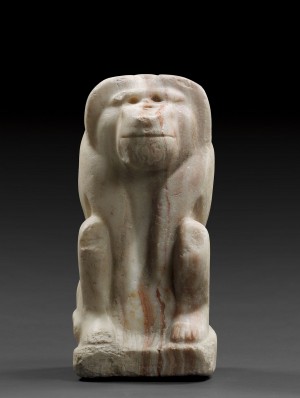The Great Dawning: The Birth of Ancient Egyptian Art
The relativity of time is a tricky business for most of us, so armchair traveling to the birth of Cleopatra in 69 B.C., or back to the completion of the Great Pyramid of Giza in 2560 B.C. feels far enough, thank you very much. Just imagine then, the surprises in store when you visit the Metropolitan Museum of Art’s new exhibit, The Dawn of Egyptian Art. The earliest examples of Egyptian art from the Pre-Dynastic and Early Dynastic periods will catapult you back to as far as 4400 B.C. So put aside your preconceptions of gilded chariots and kohl-eyed goddesses straight out of MGM studios and come along for the ride.
This outstanding exhibit comprises some 180 examples of the very earliest works of Egyptian art, gathered from the collections of the Metropolitan and twelve other museums in the United States and Europe.
“Visitors who are familiar with the appearance of hieroglyphs and other later Egyptian artistic expressions will be surprised by these early works,” commented Diana Craig Patch, assistant curator for Egyptian art.
This was a time when great creativity flourished, and the sculptures, paintings and objects, present life in all its myriad animal and human forms before form itself became codified and rigidified for all the future dynasties to come.
Animals into Art
Life, in whatever form it chooses to assume, is the overriding principle at work in this exhibit. Some of these life forms—from elephants and lions to scorpions and snakes — due to their attributes and characteristics, grew in importance and became symbols in later Egyptian culture. Habitats varied and primal themes emerged, like fertility and renewal; chaos versus order.
The Nile River was a daily source for water, food and transport, and two of the largest and most dangerous animals — the hippopotamus and the crocodile — were represented in a way that could be controlled. The artist would often depict them in an ordered motif, rather than a chaotic symbol of fear and destruction. During the Late Naqada I–early Naqada II (ca. 3700–3450 B.C.) cultural period, villages were primarily found along the floodplain’s edge, and the most common pottery was red polished ware, with black or white cross-lined images, such as a bowl deftly decorated with three hippopotami in a circle, surrounded by a wavy water motif. Amulets were also a way of harnessing their power over man. In such ways, the beasts have been charmingly domesticated.
Animals are ever present, in striking palette pieces such as The Four Dog palette from the Louvre and a two-headed turtle from the Met’s own collection that is not a monstrosity of nature, but a mating pair. These symbols of fertility often served as game boards. Frogs appeared in the tens of thousands as the floods dissipated and made them an obvious fertility image. But it is in the animal statuary that we see the true grandeur and celebration of form.
The Statue of a Jackal from Naqada III (3300-3100 B.C), created from Graywacke, the same material used for many of the palette exhibits, is exceptional. The flat stone was shaped on both sides to round out the contours. Look away too quickly and when your eyes return, his front paw has surely moved. The front limbs and lifted tail show a figure in motion rare in later Egyptian art.
Jackals, elephants, giraffes, antelopes, ostriches, leopards and lions, were just a few of the great variety of species that the earliest nomadic peoples encountered. It is little wonder that ritual hunt scenes often appear on rock art and pottery, even women’s hair combs, as the size and abilities of the hunted could hardly be overestimated. Due to abundant rainfall during this Pre-Dynastic period, the low and high desert was a vast and fecund plain. Today, the hungry roars and thundering hoofs are only a distant memory in the collective consciousness.
Memories may fade over time, but finely preserved works of art are an invaluable reminder, such as the Lion cub statue from Dynasty I (3100-2900 B.C.). This is one sculpture that speaks to the sophisticated, technical abilities of these early artisans. The use of quartzite in the modeling was rare, as the stone’s macro-crystalline structure was a highly resistant medium.
Nearby, emerging from the shadows and highlighted pedestals of the Robert Lehman court-level galleries, the real centerpiece of this exhibit appears: The Baboon Statue.
(Article continued on next page)

